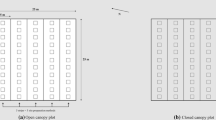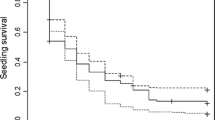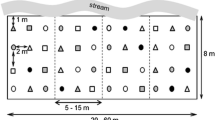Abstract
The effects of neighboring vegetation and soil fertility on the establishment, survival and growth of tree species were studied in a subtropical old-field area in south Brazil. Seed damage, germination and seedling establishment of four tree species plus growth and survival of two transplanted tree species were monitored under factorial combinations of the following treatments: (1) pioneer vegetation (presence and absence); (2) soil fertility (addition of NPK and control). Facilitation was the main process affecting plant performance. The presence of pioneer vegetation significantly improved germination, establishment, growth and survival of most study species. Around 90% of sown seeds were damaged and the removal of pioneer vegetation significantly increased seed damage for all species studied, decreased germination in three out of four species, and decreased establishment in one species. Moreover a significantly higher seedling growth rate of Inga virescens was found after the first year of the experiment in plots where vegetation was present. The presence of vegetation significantly increased seedling survival of I. virescens by protecting seedlings from leaf loss due to winter frosts. Competition was detected by the second year when a higher growth of transplanted seedlings of the species Araucaria angustifolia occurred in plots where vegetation was present and fertilizer were applied. A lower growth rate was detected in plots where vegetation was present but fertilizer was not applied. These results indicate a balance between competition for soil nutrients and protection by neighbor vegetation. Damage of seedlings by leaf cutter ants was an important barrier for plant survival. Damage occurred in 80% of the A. angustifolia seedlings and 58% of these damaged seedlings died. The presence of neighboring vegetation tended to protect seedlings from ant damage. Although competition occurred, facilitation seems to be the main process driving early successional changes in this subtropical old field. This was mainly due to the improvement of local microclimatic conditions and protection against herbivores by neighboring vegetation. Facilitation occurred during establishment and growth phases in a subtropical area that is considered a productive, low stress environment. Our results indicate that facilitation may be more frequent in productive environments than previously thought.
Similar content being viewed by others
References
Aide T.M., Cavalier J. (1994) Barriers to Lowland Tropical Forest restoration in the Sierra Nevada de Santa Marta, Colombia. Restor. Ecol. 2: 219–229
Bertness M.D., Callaway R.M. (1994) Positive interactions in communities. Trends Ecol. Evol. 9:191–193
Callaway R.M., Walker L.R. (1997) Competition and facilitation: a synthetic approach to interactions in plant communities. Ecology 78:1958–1965
Callaway R.M., Brooker R.W., Choler P., Kikvidze Z., Lortie C.J., Michalet R., Paolini L., Pugnaire F.I., Newingham B., Aschehoug E.T., Armas C., Kikodze D., Cook B.J. (2002) Positive interactions among alpine plants increase with stress. Nature 417: 844–848
Carrillo-Garcia A., Bashan Y., Rivera E.D., Bethlenfalvay G.J. (2000) Effects of resource-island soils, competition, and inoculation with Azospirillum on survival and growth of Pachycereus pringlei, the giant cactus of the Sonoran Desert. Restor. Ecol. 8: 65–73
Crawley M.J. (1983) Herbivory, the Dynamics of Animal–Plant Interactions. Blackwell Scientific Publications, Oxford
De Steven D. (1991a) Experiments on mechanisms of tree establishment in old-field succession: seedling emergence. Ecology 72:1066–1075
De Steven D. (1991b) Experiments on mechanisms of tree establishment in old-field succession: seedling survival and growth. Ecology 72:1076–1088
Duarte L.S., Dillenburg L.R. (2000) Ecophysiological responses of Araucaria angustifolia (Araucariaceae) seedlings to different irradiance levels. Aust. J. Bot. 48:531–537
Fleming R.L., Black T.A., Adams R.S., Stathers R.J. (1998) Silvicultural treatments, microclimatic conditions and seedling response in Southern interior clearcuts. Can. J. Soil Sci. 78: 115–126
Flores J., Jurado E. (2003) Are nurse-protege interactions more common among plants from arid environments? J. Veg. Sci. 14: 911–916
Foster B.L., Gross K.L. (1998) Species richness in a successional grassland: effects of nitrogen enrichment and plant litter. Ecology 79:2593–2602
Franks S.J. (2003) Facilitation in multiple life-history stages: evidence for nucleated succession in coastal dunes. Plant Ecol. 168:1–11
Ganade G. 1996. Seedling establishment in Amazon rainforest and old fields. PhD thesis, University of London.
Ganade G., Brown V.K. (2002) Succession in old pastures of central Amazonia: role of soil fertility and plant litter. Ecology 83:743–754
Gill D.S., Marks P.L. (1991) Tree and shrub seedling colonization of old fields in central New York. Ecol. Monogr. 61:183–205
Grime J.P. (1977) Evidence for the existence of three primary strategies in plants and its relevance to ecological and evolutionary theory. Am. Nat. 111:1169–1194
Hammond D.S. (1995) Post-dispersal seed and seedling mortality of tropical dry forest trees after shifting agriculture, Chiapas, Mexico. J. Trop. Ecol. 11:295–313
Huntly N. (1991) Herbivores and the dynamics of communities and ecosystems. Annu. Rev. Ecol. Syst. 22:477–503
McClanahan T.R., Wolfe R.W. (1993) Accelerating forest succession in a fragmented landscape: the role of birds and perches. Conserv. Biol. 7:279–287
Miriti M. (1998) Regeneração florestal em pastagens abandonadas na Amazônia Central: competição, predação, e dispersão de sementes. In: Gascon C., Moutinho P. (eds) Floresta Amazônica: dinâmica, regeneração e manejo. Instituto Nacional de Pesquisa da Amazônia, Manaus, pp 179–191
Myster R.W., Pickett S.T.A. (1993) Effects of litter, distance, density and vegetation patch type on postdispersal tree seed predation in old fields. Oikos 66: 381–388
Nepstad D.C., Uhl C., Serrão E.A.S. (1990) Surmounting barriers to forest regeneration in abandoned, highly degraded pastures: a case study from Paragominas, Para, Brazil. In: Anderson A.B. (eds) Alternatives to Deforestation – Steps Toward Sustainable use of the Amazon Rain Forest. Columbia University Press, New York, pp 215–229
Nepstad D.C., Uhl C., Serrão E.A.S. (1991) Recuperation of a degraded Amazonian landscape: forest recovery and agricultural restoration. Ambio 20:248–255
Nepstad D.C., Uhl C., Pereira C.A., Da Silva J.M.C. (1998) Estudo comparativo do estabelecimento de árvores em pastos abandonados e florestas adultas da Amazônia oriental. In: Gascon C., Moutinho P. (eds) Floresta Amazônica: dinâmica, regeneração e manejo. Instituto Nacional de Pesquisa da Amazônia, Manaus, pp 191–218
Nicholsorians C.M. (1991) Environmentally induced differences in plant traits – consequences for susceptibility to a leaf-cutter ant. Ecology 72: 1609–1623
Osunkoya O.O. (1994) Postdispersal survivoship of north Queensland rainforest seeds and fruits: Effects of forest, habitat and species. Aust. J. Ecol. 19:52–64
Reitz R., Klein R.M., Reis A. (1988) Projeto Madeira do Rio Grande do Sul. HBR, SUDESUL, DRNR, Brazil
Rey P.J., Alcántara J.M. (2000) Recruitment dynamics of a fleshy-fruited plant (Olea europaea): connecting patterns of seed dispersal to seedling establishment. J. Ecol. 88:622–633
SBCS (1995) Recomendações de Adubação e de Calagem para os Estados do Rio Grande do Sul e de Santa Catarina. SBCS, Passo Fundo
Schupp E.W. (1988) Seed and early seedling predation in forest understory and in treefall gaps. Oikos 51:71–78
SYSTAT (2000) SYSTAT 10 – Statistics I e II. SPSS Inc., Chicago, USA
Tilman D. (1985) The resource-ratio hypothesis of plant succession. Am. Nat. 125:827–852
Uhl C. (1987) Factors controlling succession following slash-and-burn agriculture in Amazonia. J. Ecol. 75:377–407
Uhl C., Buschbacher R., Serrão E.A.S. (1988) Abandoned pastures in eastern Amazonia. I. Patterns of Plant Sucession. J. Ecol. 76:663–681
Vieira I.C.G., Uhl C., Nepstad D. (1994) The role of the shrub Cordia multispicata Cham. as a ‘succession facilitator’ in an abandoned pasture, Paragominas, Amazônia. Vegetatio 115:91–99
Walker L.R., Chapin III F.S. (1986) Physiological controls over seedling growth in primary succession on an Alaskan floodplain. Ecology 67:1508–1523
Wilson S.D. (1999) Plant interactions during secondary succession. In: Walker L. (eds) Ecosystems of Disturbed Ground. Elsevier, New York, pp 611–632
Wilson S.D., Tilman D. (1993) Plant competition in relation to disturbance, fertility and resource availability. Ecology 74:599–611
Wilson S.D., Tilman D. (1995) Competitive responses of eight old-field plant species in four environments. Ecology 76:1169–1180
Zanini L., Ganade G. (2005) Restoration of Araucaria forest: the role of perches, pioneer vegetation, and soil fertility. Restor. Ecol. 13:507–514
Acknowledgments
We thank Maria Miriti, Mauro Galetti and Edward Benya for comments on the early version of the manuscript. We are very grateful to Flávia M. Soccol for her continuous assistance. We thank Ronei Baldissera, Simone Benedet, Fernanda Pereira, and Letícia Pedroso who helped with the field work. We thank IBAMA for offering the study area where the experiments was implemented. Lessandra Zanini received a scholarship from Coordenação de Aperfeiçoamento de Pessoal de Nível Superior - CAPES (Brazil). This work was funded by UNISINOS, Brazil.
Author information
Authors and Affiliations
Corresponding author
Rights and permissions
About this article
Cite this article
Zanini, L., Ganade, G. & Hübel, I. Facilitation and competition influence succession in a subtropical old field. Plant Ecol 185, 179–190 (2006). https://doi.org/10.1007/s11258-005-9093-0
Received:
Accepted:
Published:
Issue Date:
DOI: https://doi.org/10.1007/s11258-005-9093-0




